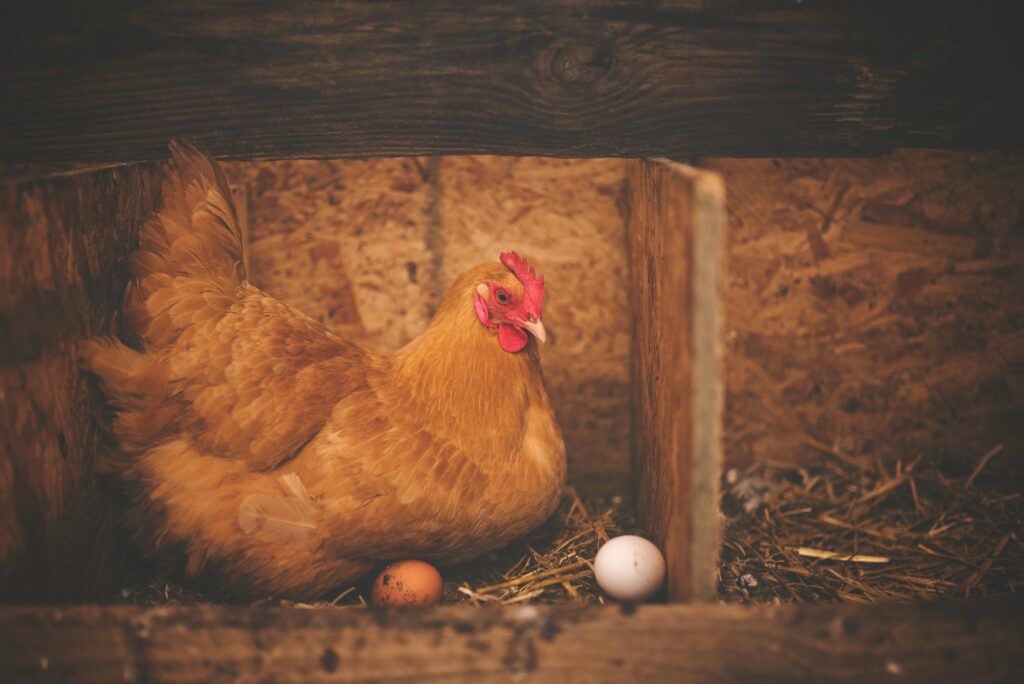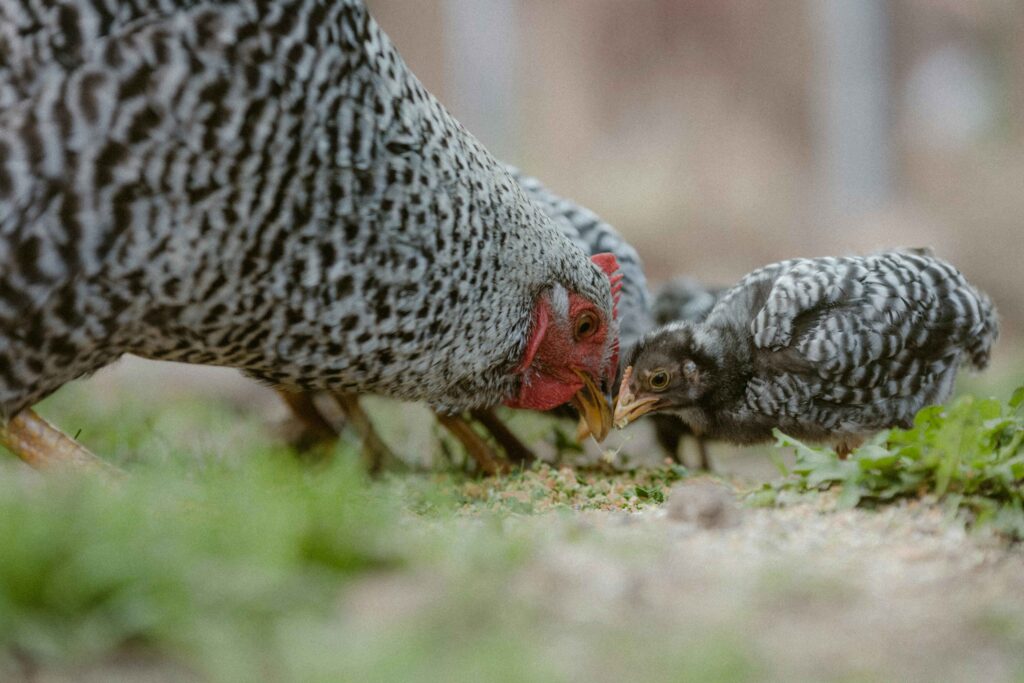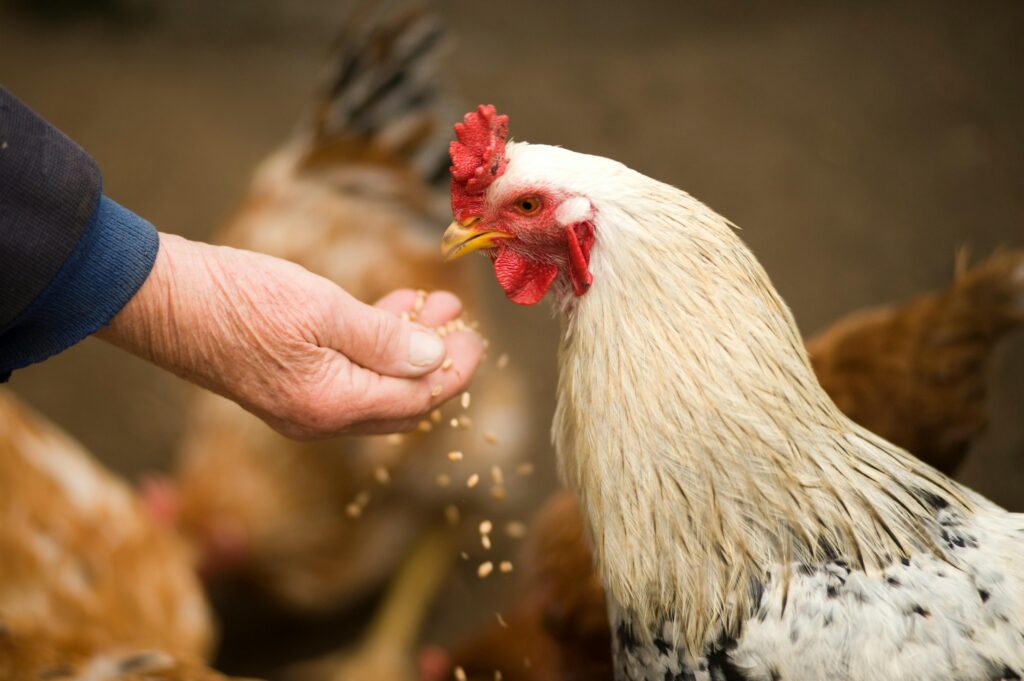Farming & Breeding Chickens for Self-Sufficiency
Raising chickens on a self-sufficient homestead can provide numerous benefits. Chickens offer more than just eggs and meat, they are valuable for pest control, manure production, and even companionship. Whether you’re a beginner or looking to expand your flock, this guide will cover the essential elements of raising chickens, from selecting breeds to building shelters and managing their diet. By the end, you’ll have a solid understanding of how to incorporate chickens into your self-sufficiency plan.

Why Farm and Breed Chickens for Self-Sufficiency?
Chickens are an excellent addition to any self-sufficient farm or homestead. They offer a wide range of benefits that can contribute to your farm’s overall sustainability and productivity.
1. Egg Production
One of the most obvious reasons to raise chickens is for fresh eggs. Hens typically start laying eggs at about 5-6 months of age, and they can continue laying for several years. A consistent supply of eggs is ideal for family consumption and can also provide extra income if you decide to sell them locally.
2. Meat Production
Raising chickens for meat, commonly known as “broilers,” can provide a source of protein for your family. While layers are bred for egg production, broilers are specifically raised for their meat, and they grow at a faster rate. If you are interested in a more sustainable and ethical source of meat, raising your own chickens can be a rewarding choice.
3. Pest Control
Chickens are natural foragers and are excellent at keeping your yard free of pests such as insects, ticks, and weeds. They will happily scratch the ground, pecking at insects, seeds, and even small rodents. This behavior can help reduce the need for chemical pesticides, further supporting your self-sufficient farming goals.
4. Manure for Fertiliser
Chicken manure is rich in nitrogen and can be used as a fertilizer for your crops. However, it must be composted first to avoid burning your plants. Chickens help to convert food scraps and bedding material into valuable compost that can enrich your soil.
5. Feathers and Other By-products
In addition to eggs and meat, chickens provide feathers that can be used in various crafts or even as insulation material. The chicken’s bones, skin, and other by-products can be used to make stock, pet food, or other products for your homestead.

Types of Chickens for Self-Sufficiency
When it comes to selecting chickens for your homestead, the breed you choose will depend on your primary goals, whether it’s egg production, meat production, or dual-purpose chickens that provide both. Here are a few types of chickens commonly raised for self-sufficiency:
1. Egg Layers
Egg-laying breeds are ideal for those who want a regular supply of fresh eggs. Some of the most popular egg-laying breeds include:
- Leghorn: Known for being hardy and excellent layers, producing white eggs.
- Rhode Island Red: These chickens are prolific egg layers, known for their hardiness and ability to adapt to a variety of climates.
- Sussex: A friendly and reliable breed that lays brown eggs.
- Plymouth Rock: Great layers and friendly, with distinctive feather patterns.
2. Meat Chickens
If your focus is on meat production, you’ll need to raise broilers – chickens specifically bred for eating. Some of the most popular meat breeds include:
- Cornish: The most common breed for commercial meat production, Cornish chickens grow quickly and are typically butchered at 6–8 weeks.
- Bresse: Known for their high-quality meat, Bresse chickens are slower to grow but produce flavorful and tender meat.
3. Dual-Purpose Breeds
Dual-purpose chickens are great for those who want both eggs and meat. These breeds are slightly less prolific in egg production compared to egg layers, but they grow large enough for meat production. Some of the best dual-purpose breeds include:
- Orpington: Known for their calm temperament, Orpingtons are great layers and have a good meat yield.
- Australorp: These hardy birds are great egg layers and also provide a decent meat yield.
- Barred Rock: A friendly and robust breed that lays a decent amount of eggs while also providing good meat.
Essential Equipment for Keeping Chickens
Raising chickens requires the right equipment to ensure their safety, health, and comfort. Here’s a breakdown of the essential materials and tools you’ll need:
1. Chicken Coop
A secure, weather-resistant chicken coop is essential for protecting your chickens from predators and harsh weather. The coop should have enough space for each chicken, with around 0.2–0.3 square meters of space per chicken. Consider the following when designing your coop:
- Ventilation: Good airflow is essential to prevent heat buildup and reduce the risk of respiratory diseases.
- Nesting Boxes: Provide one nesting box for every 3–4 hens. These should be comfortable and lined with straw or wood shavings.
- Roosting Bars: Chickens sleep on roosts, so provide them with a raised perch to rest at night. Ensure the roosting bars are a few inches above the ground.
- Predator-Proofing: Use hardware cloth instead of chicken wire to keep predators out. Make sure the coop is secure and has no gaps through which predators can get in.
2. Chicken Run
In addition to the coop, you’ll need a secure outdoor area, known as a chicken run, where the chickens can roam freely during the day. This area should be large enough to allow the chickens to forage, scratch, and exercise. The run should be fully enclosed to prevent predators from getting in, and the ground should be covered with dirt, grass, or straw to prevent mud buildup.
3. Feeding Equipment
Chickens need consistent access to food and water. The types of feeders and waterers you choose will depend on the size of your flock:
- Feeders: Consider using hanging feeders to prevent chickens from spilling food or contaminating it with their droppings. You can also choose a trough-style feeder, but be sure it’s deep enough to prevent the food from being wasted.
- Waterers: Chickens require clean water at all times. A waterer with a drip-free design is ideal to avoid spills and mess. There are several types, including gravity-fed and nipple-style waterers, which help reduce water wastage and keep the water clean.
4. Bedding
Bedding in the chicken coop is important for cleanliness and odor control. Use absorbent materials such as straw, wood shavings, or hemp bedding. These materials help keep the coop dry and comfortable while also providing insulation in colder weather.
5. Health and Hygiene Supplies
Regular cleaning and health monitoring are crucial for the well-being of your chickens. Some key supplies include:
- Shovels and Scrapers: For cleaning the coop and removing waste.
- Disinfectants: Non-toxic disinfectants are essential for cleaning and sanitizing the coop regularly.
- Health Monitoring Tools: Tools such as a chicken scale, thermometer, and veterinary supplies should be kept on hand to monitor your chickens’ health.

Food and Water Requirements for Chickens
Proper nutrition is key to raising healthy, productive chickens. Chickens require a balanced diet to ensure optimal egg production and meat growth. Here’s a general breakdown of their nutritional needs:
1. Feed Types
- Starter Feed: Chickens need a high-protein starter feed for the first 6–8 weeks of life to promote strong growth and development.
- Grower Feed: After the starter phase, switch to grower feed, which has a lower protein content and supports the transition to adulthood.
- Layer Feed: Once hens begin laying eggs, they should be transitioned to layer feed, which contains added calcium for strong eggshells.
- Broiler Feed: For meat birds, broiler feed is designed to promote fast growth and muscle development.
2. Supplementing Their Diet
Chickens are omnivores and can enjoy a variety of foods beyond their standard feed, including:
- Kitchen Scraps: Chickens love leftovers like vegetable peels, bread, and grains.
- Grit: Chickens need grit (small stones or sand) to help them digest food properly.
- Greens: Offering fresh greens like lettuce, kale, and grass can improve their overall health and nutrition.
3. Water
Fresh, clean water is essential at all times. Chickens can drink several litres of water a day, especially during hot weather or peak egg production.

Shelters and Equipment for Chickens
Creating the right environment for your chickens is vital for their health and productivity. Chickens need a comfortable and secure shelter to ensure they are protected from predators, weather conditions, and other stressors. Here’s what you should consider when setting up chicken shelters:
Chicken Coop Design
- Space Requirements: Chickens need enough space to roam around and nest. A standard rule of thumb is about 0.2-0.4 square meters per chicken in the coop, with additional space for the outdoor run.
- Ventilation: Proper ventilation is crucial to prevent ammonia buildup from chicken droppings, which can be harmful to their health. Consider installing mesh windows or ventilation holes that can be adjusted for temperature and airflow.
- Predator Protection: Ensure that your coop is secure from predators like foxes, hawks, and rats. Use strong materials like welded wire mesh for walls and doors, and bury mesh around the perimeter to prevent burrowing predators.
- Nesting Boxes: Provide one nesting box for every 3-4 hens. These should be placed in a quiet, dark corner to encourage egg-laying and prevent disturbances.
- Perches: Chickens like to perch, so providing horizontal bars or logs will allow them to roost comfortably at night.
- Bedding: Use straw, wood shavings, or hay as bedding to absorb moisture and provide a comfortable surface. Be sure to clean the bedding regularly to maintain good hygiene.
Outdoor Run
- Fencing: A secure outdoor run is essential for chickens to stretch their legs and forage. Use fencing that is at least 1.5 meters high to prevent them from flying out, and bury the fencing about 15 cm below ground to prevent predators from digging under.
- Shade and Shelter: Provide shaded areas to protect chickens from excessive sun, and a sheltered space where they can seek refuge in case of rain or harsh weather.
- Free-Range Areas: If you choose to free-range your chickens, ensure the area is safe from predators and that the chickens have access to natural food sources like grass, bugs, and seeds.
Estimated Costs and Land Size for Breeding Chickens
Starting a small flock of chickens for self-sufficiency can be quite affordable, but there are still some initial costs to consider. Here’s an overview of costs and land size needs:
Initial Setup Costs
- Chicken Coop: Depending on the size and quality of materials, a simple chicken coop can range from $200 to $1,000. Pre-made coops tend to be more expensive, while DIY options can save costs.
- Chicken Feed: Expect to spend around $20 to $40 per month on chicken feed for a small flock of 5-10 hens.
- Waterers and Nesting Boxes: Waterers generally cost between $20 and $50, while nesting boxes can range from $10 to $30 each.
- Chickens: The price of chickens varies based on breed and age. Pullets (young hens) can cost between $15 and $30 each, while mature laying hens may cost $30 to $50 or more.
Ongoing Costs
- Feed and Supplements: Feed costs are the main ongoing expense for raising chickens. You can expect to spend between $300 to $500 annually for a flock of 10 hens, depending on their diet.
- Bedding: You’ll also need to replace bedding regularly, which costs about $5 to $10 per month.
Land Size Requirements
- A small flock of chickens typically needs a coop space of around 1 square meter per bird and an outdoor run of about 2 to 4 square meters per bird. If you’re keeping chickens for egg production, a small backyard can suffice. However, larger flocks for meat production may require more space.
- Ideally, you’ll want to have at least 100 to 200 square meters of land for free-ranging chickens, though chickens can be raised in smaller spaces if they are contained in a secure run.
Health and Care Considerations for Chickens
Taking good care of your chickens will ensure they stay healthy and productive. Here are some essential aspects to keep in mind:
Vaccination and Disease Prevention
- Common Poultry Diseases: Chickens are susceptible to diseases like avian influenza, Newcastle disease, and Marek’s disease. Regularly check for symptoms such as lethargy, changes in egg production, or unusual behavior. In some cases, vaccines may be necessary.
- Parasite Control: Chickens can get external parasites like mites, lice, and fleas, as well as internal parasites like worms. Regularly inspect chickens for signs of infestations and treat with appropriate dewormers or pesticides if needed.
General Healthcare
- Feather Care: Chickens may molt once a year, which is a natural process where they shed old feathers and grow new ones. Ensure they have a nutritious diet during this time to support feather regrowth.
- Leg and Foot Health: Chickens can develop leg and foot problems like bumblefoot, so regularly check their feet for cuts, swellings, or infections. Clean the coop regularly to maintain a safe environment.
